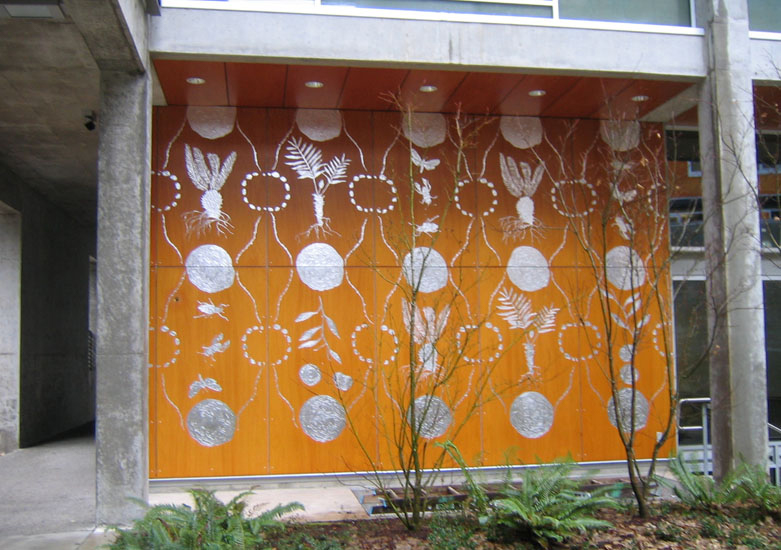The fence that runs the length of the platforms is a combination of a traditional American picket fence combined with natural imagery. The overall suggestion is one of transition from the human made environment to the world of nature, much like the area around Minnehaha Falls. Imagery on the fence includes plants and birds native to Minnesota. The wheels and grinding stones within the patterns are taken directly from photos of historic grain mills and factories along the light-rail route.

Grain mill equipment

Wren
Deborah Mersky, a Blanco County, Texas artist, is both a studio artist and a designer in the field of public art.
Her creations in both realms, are born from the overlap of nature and human habitation, which she views as a “delicate, and off kilter moment.”
In the studio, in addition to drawing and painting, Mersky uses a clay printing technique where she carves the surface of a clay slab, then prints it with oil-based inks. Her work has been shown nationally in galleries and is in collections as diverse as MICROSOFT and the Fundacion Altos de Chavon in the Dominican Republic. In public spaces, she has created pieces for libraries, hospitals, parks, light rail and public utility facilities in Washington, Oregon, California, Minnesota and Texas.
Mersky was awarded the Jentel Residency, Sheriden, Wyoming, and she is the Founder/Teacher of Art Test, San Antonio, Texas, where she was awarded for her work as 2016 Art Educator of the Year, by the McNay Art Museum San Antonio.
deborahmersky.com

Cycad Wall, Mersky, Evergreen State College
The artwork at 50th Street/Minnehaha Park Station is based on the natural world of Minnehaha Park that is located along the light-rail line. The park was officially named Minnehaha State Park when it was purchased by Minneapolis for the state of Minnesota in 1889. The name Minnehaha comes from words in the Dakota language that mean waterfall. The popular translation of “laughing waters” comes from a too literal translation of “ha ha”.
Minnehaha Falls and the land surrounding it was one of the first state parks in the United States when it was purchased. Only New York had created a state park at that time. But the state of Minnesota only paid for the park indirectly and never had a hand in maintaining it. The city of Minneapolis put up the money to buy it and managed it from the beginning.

This city park alongside the Mississippi River offers pristine beauty, a big waterfall with pools for wading, paths for activities and lawns for picnics.

The park also includes a large off-leash dog park along the river.

The park is home to a restaurant, playgrounds, sports fields, picnic shelters, concerts and lots of trails.